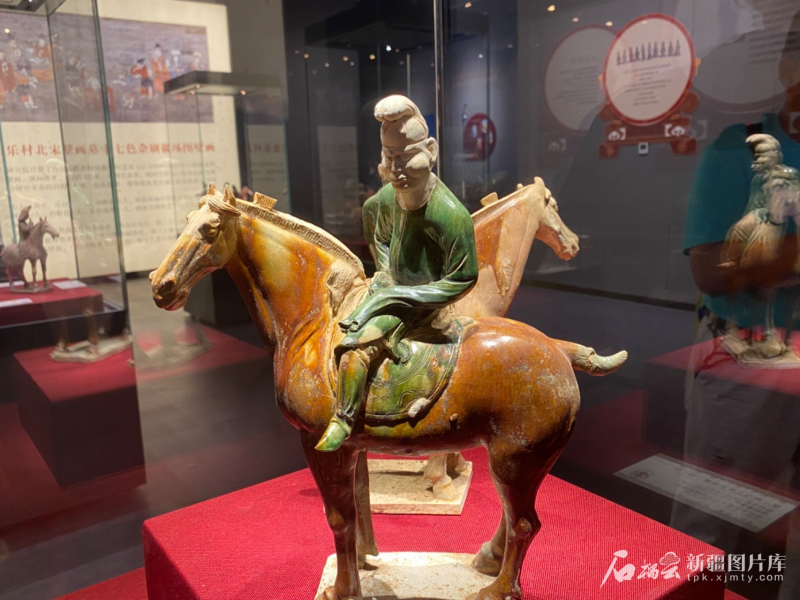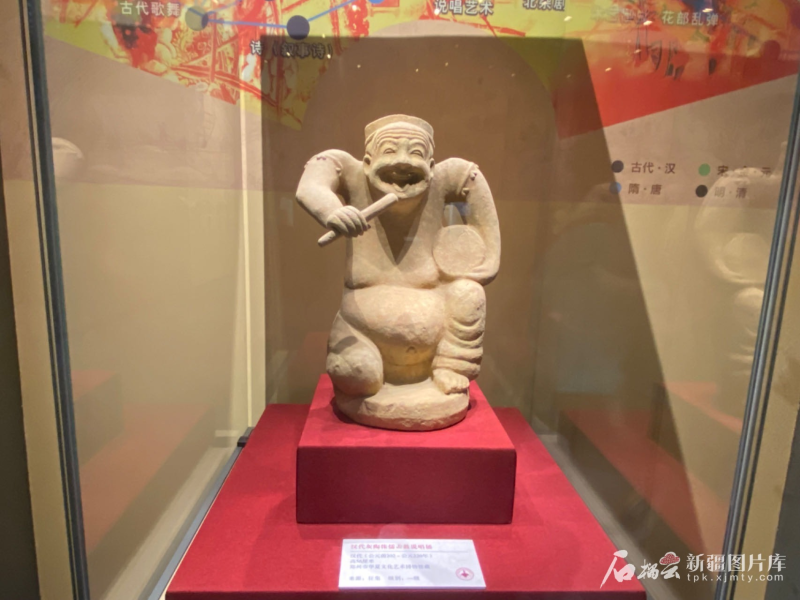Shiliuyun-Xinjiang Daily (Reporter Zhao Mei) news: What did rappers look like a thousand years ago? And what was the image of the earliest internet celebrities with massive popularity? On May 16, 2025, the "Weiyang Grand Music - An Exhibition of Precious Cultural Relics Showcasing Music, Dance, and Opera from the Han, Tang, Song, and Yuan Dynasties along the Yellow River Basin" opened at the Urumqi Museum in Urumqi City, northwest China's Xinjiang Uygur Autonomous Region. The exhibition featured 82 sets of precious cultural relics, recreating the glorious history of music, dance, and opera from the Han and Tang dynasties to the Song and Yuan dynasties.

Photo taken on May 16, 2025 shows the "Weiyang Grand Music - An Exhibition of Precious Cultural Relics Showcasing Music, Dance, and Opera from the Han, Tang, Song, and Yuan Dynasties along the Yellow River Basin" opened at the Urumqi Museum in Urumqi City, northwest China's Xinjiang Uygur Autonomous Region. (Photo by Shiliuyun-Xinjiang Daily/ Zhao Mei)
This exhibition is jointly organized by the Urumqi Museum and the Huaxia Culture and Art Museum in Zhengzhou City, central China's Henan Province. Li Baozong, the curator of the Huaxia Culture and Art Museum in Zhengzhou, introduced that the exhibits include national first-, second-, and third-grade cultural relics, spanning a millennium of history from the Han Dynasty to the Yuan Dynasty. Among them, 22 national first-grade cultural relics account for 37.8 percent of the total, including precious items such as gray pottery figurines of music, dance, and acrobatic performances from the Han Dynasty, music and dance figurines from the Wei, Jin, Southern and Northern Dynasties, and three-colored glazed figurines depicting theatrical performances from the Tang Dynasty. The most distinctive among them are the brick carvings of Zaju (a form of Chinese opera) from the Song Dynasty. The exhibition will run until August 15, 2025.

Photo shows the three-colored glazed figurines depicting theatrical performances from the Tang Dynasty. (Photo by Shiliuyun-Xinjiang Daily/ Zhao Mei)
Chinese music and dance art originated in the pre-Qin period. By the Han and Tang dynasties, with the prosperity of the Silk Road, the "music, dance, and acrobatic performances" that integrated diverse cultures reached their zenith. During the Song and Yuan dynasties, the flourishing of the Maritime Silk Road gave birth to Zaju (a form of Chinese opera) in the entertainment quarters of cities. This art form was subsequently inherited and further developed by Jin Dynasty court dramas, Southern Opera, and Yuan Zaju (a form of Chinese drama in the Yuan Dynasty).

Photo shows a set of brick carvings of Zaju plays from the seventh year of the Dading period of the Jin Dynasty. (Photo by Shiliuyun-Xinjiang Daily/ Zhao Mei)
Stepping into the exhibition hall, one is immediately struck by the vivid and lifelike music and dance figurines of various kinds. Some are seen playing the pipa (a Chinese lute), others are blowing the bili (an ancient Chinese reed instrument), some are beating drums, while still others form music and dance troupes performing together.

Photo shows a set of long-horned figurines of horseback musicians and entertainers from the Tang Dynasty. (Photo by Shiliuyun-Xinjiang Daily/ Zhao Mei)
A particularly eye-catching figurine is that of a storyteller-cum-percussionist from the Eastern Han Dynasty, which vividly recreates the image of a "rapper" from that era. This 56-centimeter-tall gray pottery figurine, made of clay, holds a drum in its left hand and a drumstick in its right, with shoulders hunched high and exaggerated movements, as if it is about to raise its arm to strike the drum, urging all the onlookers to "swing" along with it.

Photo shows a Han Dynasty gray pottery figurine of a dwarf beating a drum and singing. (Photo by Shiliuyun-Xinjiang Daily/ Zhao Mei)
A brick carving from the Northern Song Dynasty depicts the images of four renowned opera stars of the time, i.e., Yang Huxi, Ding Dusai, Si Lian'er, and Xue Zixiao. According to "Records of the Dreamlike Splendors of Dongjing" (a historical account of Bianjing, the capital of the Northern Song Dynasty), famous Zaju (a form of Chinese opera) performers who were well-known throughout the capital city during the Northern Song Dynasty included "Xiao Zhu'er, Ding Dusai, Xue Zida, Xue Zixiao, Yang Huxi, Cui Shangshou," and others. They were not only celebrated among the common people but also performed for the emperor, making them the "internet celebrities" of their time and the earliest named and renowned opera stars in Chinese history.

Photo shows a set of brick carvings with inscriptions of Zaju plays carved in plain lines from the Northern Song Dynasty. (Photo by Shiliuyun-Xinjiang Daily/ Zhao Mei)
"This collection of precious cultural relics not only documents the developmental journey of Chinese music, dance, and opera but also bears witness to the exchanges, integration, and clashes in music and dance among various regions along the ancient Silk Road. More importantly, they showcase the glorious process of the Chinese nation evolving from diversity into unity!" said Li Baozong.
(A written permission shall be obtained for reprinting, excerpting, copying and mirroring of the contents published on this website. Unauthorized aforementioned act shall be deemed an infringement, of which the actor shall be held accountable under the law.)









